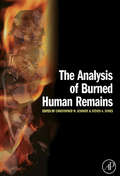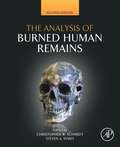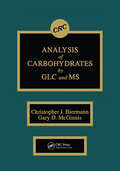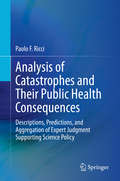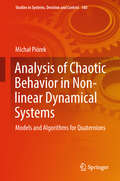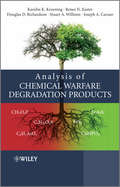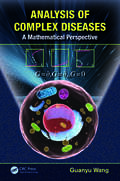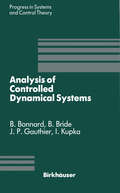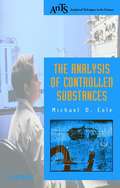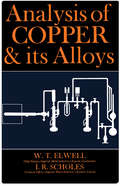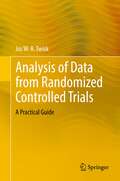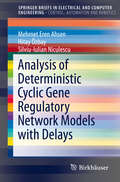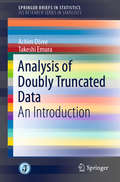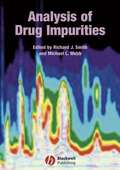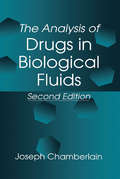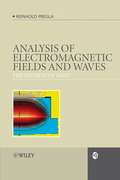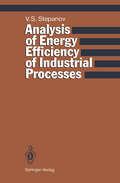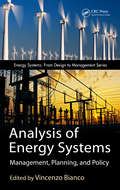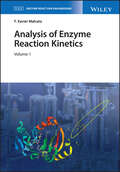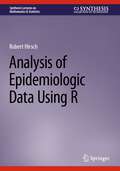- Table View
- List View
The Analysis of Burned Human Remains (Atlas Of Surgical Pathology Ser.)
by Steven A. Symes Christopher W. SchmidtThis unique reference provides a primary source for osteologists and the medical/legal community for the understanding of burned bone remains in forensic or archaeological contexts. It describes in detail the changes in human bone and soft tissues as a body burns at both the chemical and gross levels and provides an overview of the current procedures in burned bone study. Case studies in forensic and archaeological settings aid those interested in the analysis of burned human bodies, from death scene investigators, to biological anthropologists looking at the recent or ancient dead.Includes the diagnostic patterning of color changes that give insight to the severity of burning, the positioning of the body, and presence (or absence) of soft tissues during the burning eventChapters on bones and teeth give step-by-step recommendations for how to study and recognize burned hard tissues
The Analysis of Burned Human Remains
by Steven A. Symes Christopher W. SchmidtThe Analysis of Burned Human Remains, Second Edition, provides a primary source for osteologists and the medical/legal community for the understanding of burned bone remains in forensic or archaeological contexts. It describes in detail the changes in human bone and soft tissues as a body burns at both the chemical and gross levels and provides an overview of the current procedures in burned bone study. Case studies in forensic and archaeological settings aid those interested in the analysis of burned human bodies, from death scene investigators to biological anthropologists.A timely state-of-the-art analyses of burned bone studies for bioarchaeologists and forensic anthropologistsCovers the diagnostic patterning of color changes, the positioning of the body, and presence (or absence of soft tissues during the burning eventChapters on bones and teeth give step-by-step recommendations for hot to study and recognize burned hard tissuesNew chapters include improved analyses of thermally induced impacts on bone microstructure, development, and appearance; they also cover sites from a greater geographic range adding Alaska, Italy, Jordan, Mexico, and Southeast Asia
Analysis of Carbohydrates by GLC and MS
by Christopher J. Biermann Gary D. McGinnisThis textbook is a comprehensive guide to analysis of carbohy-drates by gas-liquid chromatography and mass spectrometry. In addition to explaining the facets of carbohydrate analysis and their relation to each other, the text also contains in-depth reference in-formation useful to practitioners in the field. Improvements in car-bohydrate analyses methodology during the past six years are also highlighted. This extensively illustrated text provides excellent data for those in carbohydrate, agriculture, and food chemistry.
Analysis of Carbohydrates by GLC and MS
by Christopher J. Biermann Gary D. McGinnisThis textbook is a comprehensive guide to analysis of carbohy-drates by gas-liquid chromatography and mass spectrometry. In addition to explaining the facets of carbohydrate analysis and their relation to each other, the text also contains in-depth reference in-formation useful to practitioners in the field. Improvements in car-bohydrate analyses methodology during the past six years are also highlighted. This extensively illustrated text provides excellent data for those in carbohydrate, agriculture, and food chemistry.
Analysis of Catastrophes and Their Public Health Consequences: Descriptions, Predictions, and Aggregation of Expert Judgment Supporting Science Policy
by Paolo F. RicciPublic health policy prospectively and retrospectively addresses the consequences of events ranging from the commonplace to the catastrophic. Informing policymakers and stakeholders by enhancing their understanding of complex causation to justify remedial or precautionary actions is a critical science-policy task. In this book, the key aspects of catastrophes (regardless of their nature) and routine events are identified through a common framework for their analyses, and the analyses of the consequences associated with the potential occurrence of these events also are discussed. The book is not about disaster planning; instead, it is focused on analysis and causation in the context of informing – rather than formulating – public health policy. The author aggregates and fuses scientific information and knowledge in public health policy-science using alternative but complementary methods. The book first focuses on the analysis of catastrophes and commonplace events; the focus then shifts to causal models of multifactorial diseases, particularly at low doses or dose-rates, associated with these events. Topics explored among the chapters include:Policy and Legal Aspects of Precautionary ChoicesCatastrophes, Disasters, and Calamities: Concepts for Their Assessment Uncertainty: Probabilistic and Statistical AspectsAggregating Judgments to Inform Precautionary Decision-makingThe aim of the book is to show that the analyses of events are fundamentally similar, regardless of whether the concern is a global catastrophe or commonplace. Analysis of Catastrophes and Their Public Health Consequences is a text that should engage students, instructors, and researchers in public health, science policy, and preparedness research, as well as serve as a useful resource for policy analysts, practitioners, and risk managers.
Analysis of Chaotic Behavior in Non-linear Dynamical Systems: Models and Algorithms for Quaternions (Studies in Systems, Decision and Control #160)
by Michał PiórekThis book presents a new approach for the analysis of chaotic behavior in non-linear dynamical systems, in which output can be represented in quaternion parametrization. It offers a new family of methods for the analysis of chaos in the quaternion domain along with extensive numerical experiments performed on human motion data and artificial data. All methods and algorithms are designed to allow detection of deterministic chaos behavior in quaternion data representing the rotation of a body in 3D space. This book is an excellent reference for engineers, researchers, and postgraduate students conducting research on human gait analysis, healthcare informatics, dynamical systems with deterministic chaos or time series analysis.
Analysis of Chemical Warfare Degradation Products
by Karolin K. Kroening Renee N. Easter Douglas D. Richardson Stuart A. Willison Joseph A. CarusoThis book describes nerve agents and vesicants, their decomposition and their degradation products' chemistry as well as their toxicity including a list of detection techniques of nerve agents and their degradation products. This book will present their history, toxicity, comparison between different sample preparation methods, separation techniques, and detection methods all together in a short, easy to read book, tied together by a single group doing the writing and the editing to assure smooth transition from chapter to chapter, with sufficient Tables and literature references for the reader who looks to further detail.The text will illustrate the pluses and minuses of the various techniques with sufficient references for the reader to obtain extensive detail.
Analysis of Chemical Warfare Degradation Products
by Karolin K. Kroening Renee N. Easter Douglas D. Richardson Stuart A. Willison Joseph A. CarusoThis book describes nerve agents and vesicants, their decomposition and their degradation products' chemistry as well as their toxicity including a list of detection techniques of nerve agents and their degradation products. This book will present their history, toxicity, comparison between different sample preparation methods, separation techniques, and detection methods all together in a short, easy to read book, tied together by a single group doing the writing and the editing to assure smooth transition from chapter to chapter, with sufficient Tables and literature references for the reader who looks to further detail.The text will illustrate the pluses and minuses of the various techniques with sufficient references for the reader to obtain extensive detail.
Analysis of Complex Diseases: A Mathematical Perspective
by PhD, Guanyu WangA complex disease involves many etiological and risk factors operating at multiple levels-molecular, cellular, organismal, and environmental. The incidence of such diseases as cancer, obesity, and diabetes are increasing in occurrence, urging us to think fundamentally and use a broader perspective to identify their connection and revolutionize trea
Analysis of Controlled Dynamical Systems: Proceedings of a Conference held in Lyon, France, July 1990 (Progress in Systems and Control Theory #8)
by B. Bonnard B. Bride J. P. Gauthier I. KupkaThe conference "Analysis of Controlled Dynamical Systems" was held in July 1990 at the University of LYON FRANCE. About hundred participants attended this conference which lasted four days : There were 50 speakers from departments of Engineering and Mathematics in east and west Europe, USA and USSR. The general subject of the conference was system theory. The main topics were optimal control, structure and control of nonlinear systems, stabilization and observers, differential algebra and systems theory, nonlinear aspects of Hoc theory, rigid and flexible mechanical systems, nonlinear analysis of signals. We are indebted to the scientific committee John BAILLIEUL, Michel FLIESS, Bronislaw JAKUBCZYCK, Hector SUSSMANN, Jan WILLEMS. We gratefully acknowledge the time and thought they gave to this task. We would also like to thank Chris BYRNES for arranging for the publication of these proceedings through the series "Progress in Systems and Control Theory"; BIRKHAUSER. Finally, we are very grateful to the following institutions who through their financial support contributed essentially to the success of this conference : CNRS, Special year " Systemes Dynamiques", DRET, MEN-DAGIC, GRECO-AUTOMATIQUE, Claude Bernard Lyon I University, Entreprise Rhone-Alpes International, Conseil General du RhOne, the cities of LYON and VILLEURBANNE.
The Analysis of Controlled Substances (Analytical Techniques in the Sciences (AnTs) *)
by Michael D. ColePresenting new developments in sampling and drug profiling, this book also provides practical information on how to carry out analysis, what the results mean and how they can be used as court evidence and for drugs intelligence purposes. * Includes case-studies with full data and spectra, helping readers to identify substances * Accessibly organized by class of compound * Contains an up-to-date list of the newest drugs
Analysis of Copper and Its Alloys
by W. T. Elwell I. R. ScholesAnalysis of Copper and Its Alloys provides important information for the satisfactory analysis of typical industrial products. This book presents several instrumental methods for analysis, which involve the use of instruments that are familiar, even in small laboratories. Organized into 34 chapters, this book starts with an overview of the various factors that are common to most methods of sampling copper-base materials, regardless of the quality and quantity of material to be sampled. This text then discusses the safety precautions pertaining to the handling of reagents and apparatus. Other chapters consider the factors that influence the determination when copper is electrolytically deposited in the conventional way, including the simultaneous co-deposition of other metals, the retention of copper, and the inhibiting effect of metals. This book discusses as well the presence of refractory tin oxide in tin-bearing alloys. This book is a valuable resource for chemists, teachers, students, and researchers.
Analysis of Data from Randomized Controlled Trials: A Practical Guide
by Jos W.R. TwiskThis book provides a practical guide to the analysis of data from randomized controlled trials (RCT). It gives an answer to the question of how to estimate the intervention effect in an appropriate way. This problem is examined for different RCT designs, such as RCTs with one follow-up measurement, RCTs with more than one follow-up measurement, cluster RCTs, cross-over trials, stepped wedge trials, and N-of-1 trials. The statistical methods are explained in a non-mathematical way and are illustrated by extensive examples. All datasets used in the book are available for download, so readers can reanalyse the examples to gain a better understanding of the methods used. Although most examples are taken from epidemiological and clinical studies, this book is also highly recommended for researchers working in other fields.
Analysis of Deterministic Cyclic Gene Regulatory Network Models with Delays (SpringerBriefs in Electrical and Computer Engineering)
by Mehmet Eren Ahsen Hitay Özbay Silviu-Iulian NiculescuThis brief examines a deterministic, ODE-based model for gene regulatory networks (GRN) that incorporates nonlinearities and time-delayed feedback. An introductory chapter provides some insights into molecular biology and GRNs. The mathematical tools necessary for studying the GRN model are then reviewed, in particular Hill functions and Schwarzian derivatives. One chapter is devoted to the analysis of GRNs under negative feedback with time delays and a special case of a homogenous GRN is considered. Asymptotic stability analysis of GRNs under positive feedback is then considered in a separate chapter, in which conditions leading to bi-stability are derived. Graduate and advanced undergraduate students and researchers in control engineering, applied mathematics, systems biology and synthetic biology will find this brief to be a clear and concise introduction to the modeling and analysis of GRNs.
Analysis of Doubly Truncated Data: An Introduction (SpringerBriefs in Statistics)
by Takeshi Emura Achim DörreThis book introduces readers to statistical methodologies used to analyze doubly truncated data. The first book exclusively dedicated to the topic, it provides likelihood-based methods, Bayesian methods, non-parametric methods, and linear regression methods. These procedures can be used to effectively analyze continuous data, especially survival data arising in biostatistics and economics. Because truncation is a phenomenon that is often encountered in non-experimental studies, the methods presented here can be applied to many branches of science. The book provides R codes for most of the statistical methods, to help readers analyze their data. Given its scope, the book is ideally suited as a textbook for students of statistics, mathematics, econometrics, and other fields.
Analysis of Drug Impurities (Sheffield Analytical Chemistry Series)
by Richard J. Smith Michael L. WebbA key component of the overall quality of a pharmaceutical is control of impurities, as their presence, even in small amounts, may affect drug safety and efficacy. The identification and quantification of impurities to acceptable standards presents a significant challenge to the analytical chemist. Analytical science is developing rapidly and provides increasing opportunity to identify the structure, and therefore the origin and safety implications of these impurities, and the challenges of their measurement drives the development of modern quantitative methods. Written for both practicing and student analytical chemists, Analysis of Drug Impurities provides a detailed overview of the challenges and the techniques available to permit accurate identification and quantification of drug impurities.
The Analysis of Drugs in Biological Fluids
by Joseph ChamberlainThis new edition focuses on a variety of techniques available for the analysis of drugs in biological fluids. Over 150 figures and tables help to describe the latest advances and give examples of their applications. Current chiral analysis methods as well as discussions on the impact of chirality are described. Practical aspects of bioanalytical work, including many examples of laboratory problems not often reported in the scientific literature, are examined in depth.
The Analysis of Drugs in Biological Fluids
by Joseph ChamberlainThis new edition focuses on a variety of techniques available for the analysis of drugs in biological fluids. Over 150 figures and tables help to describe the latest advances and give examples of their applications. Current chiral analysis methods as well as discussions on the impact of chirality are described. Practical aspects of bioanalytical work, including many examples of laboratory problems not often reported in the scientific literature, are examined in depth.
Analysis of Electromagnetic Fields and Waves: The Method of Lines (RSP #21)
by Reinhold PreglaThe Method of Lines (MOL) is a versatile approach to obtaining numerical solutions to partial differential equations (PDEs) as they appear in dynamic and static problems. This method, popular in science and engineering, essentially reduces PDEs to a set of ordinary differential equations that can be integrated using standard numerical integration methods. Its significant advantage is that the analysis algorithms follow the physical wave propagation and are therefore efficient. This is because the fields on the discretisation lines are described by generalised transmission line (GTL) equations. With this formulation we have a connection to the well known transmission line theory and resulting in an easy understanding. The method of lines is a very accurate and powerful way to analyze electromagnetic waves, enabling a full-wave solution without the computational burden of pure finite element or finite difference methods. With Analysis of Electromagnetic Fields and Waves, Reinhold Pregla describes an important and powerful method for analyzing electromagnetic waves. This book: Describes the general analysis principles for electromagnetic fields. Includes applications in microwave, millimetre wave and optical frequency regions. Unifies the analysis by introducing generalised transmission line (GTL) equations for all orthogonal coordinate systems and with materials of arbitrary anisotropy as a common start point. Demonstrates a unique analysis principle with the numerical stable impedance/admittance transformation and a physical adapted field transformation concept that is also useful for other modelling algorithms. Includes chapters on Eigenmode calculations for various waveguides, concatenations and junctions of arbitrary number of different waveguide sections in complex devices, periodic structures (e.g. Bragg gratings, meander lines, clystron resonators, photonic crystals), antennas (e.g. circular and conformal). Enables the reader to solve partial differential equations in other physical areas by using the described principles. Features an accompanying website with program codes in Matlab© for special problems. Analysis of Electromagnetic Fields and Waves will appeal to electromagnetic field practitioners in primary and applied research as well as postgraduate students in the areas of photonics, micro- and millimetre waves, general electromagnetics, e.g. microwave integrated circuits, antennas, integrated and fibre optics, optoelectronics, nanophotonics, microstructures, artificial materials.
Analysis of Energy Efficiency of Industrial Processes
by Vladimir S. StepanovIt is universally recognized that the end of the current and the beginning of the next century will be characterized by a radical change in the existing trends in the economic development of all countries and a transition to new principles of economic management on the basis of a resource and energy conservation policy. Thus there is an urgent necessity to study methods, technical aids and economic consequences of this change, and particularly, to determine the possible amounts of energy resources which could be conserved (energy "reserves") in different spheres of the national economy. An increased interest towards energy conservation in industry, one of the largest energy consumers, is quite natural and is manifested by the large num ber of publications on this topic. But the majority of publications are devoted to the solution of narrowly defined problems, determination of energy reserves in specific processes and plants, efficiency estimation of individual energy conserva tion measures, etc. However, it is necessary to develop a general methodological approach to the solution of such problems and create a scientific and methodical base for realizing an energy conservation policy. Such an effort is made in this book, which is concerned with methods for studying energy use efficiency in technological processes and estimation of the theoretical and actual energy reserves in a given process, technology, or industrial sector on the basis of their complete energy balances.
Analysis of Energy Systems: Management, Planning and Policy (Energy Systems)
by Vincenzo BiancoThe analysis of energy systems is of paramount importance in modern societies, since it is fundamental to guarantee a sustainable economic development. It combines technical and economic research with a specific focus on quantitative modelling, in order to optimize the modalities of energy demand and supply globally. The book covers major advanced topics related to the analysis of energy by considering different aspects, namely management, planning and policies. The most recent trends, such as smart grids, transition from fossil fuels to renewables based energy systems and distributed generation, are also discussed in this book. Intended to be a collection of various contributions from experts all around the world, it includes latest research results, innovations and methodologies about the analysis of energy systems. The book also focuses to contribute to the current debate related to the evolution of energy systems, by discussing in an open way the pro’s and con’s without any pre-constitute point of view. Title is aimed to be a reference for the academic community, students and professionals with a wider interdisciplinary background. Key Features: Presents integration of renewable sources with conventional energy systems. Topic is addressed from a multidisciplinary point of view, i.e. economy, technical, modelling, planning. Investigates management and planning aspects of future energy supplies. Multidimensional nature of energy systems is highlighted and discussed. Contributes towards implementing policy measures to reduce primary energy consumptions and carbon footprint.
Analysis of Energy Systems: Management, Planning and Policy (Energy Systems)
by Vincenzo BiancoThe analysis of energy systems is of paramount importance in modern societies, since it is fundamental to guarantee a sustainable economic development. It combines technical and economic research with a specific focus on quantitative modelling, in order to optimize the modalities of energy demand and supply globally. The book covers major advanced topics related to the analysis of energy by considering different aspects, namely management, planning and policies. The most recent trends, such as smart grids, transition from fossil fuels to renewables based energy systems and distributed generation, are also discussed in this book. Intended to be a collection of various contributions from experts all around the world, it includes latest research results, innovations and methodologies about the analysis of energy systems. The book also focuses to contribute to the current debate related to the evolution of energy systems, by discussing in an open way the pro’s and con’s without any pre-constitute point of view. Title is aimed to be a reference for the academic community, students and professionals with a wider interdisciplinary background. Key Features: Presents integration of renewable sources with conventional energy systems. Topic is addressed from a multidisciplinary point of view, i.e. economy, technical, modelling, planning. Investigates management and planning aspects of future energy supplies. Multidimensional nature of energy systems is highlighted and discussed. Contributes towards implementing policy measures to reduce primary energy consumptions and carbon footprint.
Analysis of Enzyme Reaction Kinetics (Enzyme Reaction Engineering)
by F. Xavier MalcataComprehensively introduces readers to modelling of rate of enzymatic reactions, including effects of physicochemical parameters Analysis of Enzyme Reaction Kinetics is the second set in a unique eleven-volume collection on Enzyme Reactor Engineering. It describes rate expressions pertaining to enzymatic reactions, including modulation by physicochemical factors, as well as tools for prediction and control of how fast substrates are transformed to products. Volume 1 details rate expressions mathematically derived from mechanistic postulates, and is complemented by appropriate statistical approaches to fit them to experimental data. Volume 2 discusses the effects of physical and chemical parameters upon the rates of both enzyme-catalyzed and enzyme-deactivation reactions. Starting with basic concepts and historical perspectives, the first volume introduces readers to the mathematics of rate expressions. It then goes on to cover kinetic features and the many forms of Michaelis & Menten’s-type rate expressions (single and multiple enzymes, autocatalysis, single and multiple substrates, multiphasic systems, etc.), and concludes with the statistical analysis of rate expressions – including the assessment of data, fitting of models to data, and generation of data themselves. The second volume introduces readers to physicochemical modulation of reaction rate – starting with basic concepts, and looking specifically at temperature-, mechanical force-, pH- and compound-driven effects: both unimodal and bimodal deactivation are considered. Analysis of Enzyme Reaction Kinetics 2V Set is a comprehensive work for those studying or working with enzyme reactions, or practitioners involved in the control of reactors. SERIES INFORMATION Enzyme Reactor Engineering is organized into four major sets: Enzyme Reaction Kinetics and Reactor Performance; Analysis of Enzyme Reaction Kinetics; Analysis of Enzyme Reactor Performance; and Mathematics for Enzyme Reaction Kinetics and Reaction Performance.
Analysis of Enzyme Reaction Kinetics (Enzyme Reaction Engineering)
by F. Xavier MalcataComprehensively introduces readers to modelling of rate of enzymatic reactions, including effects of physicochemical parameters Analysis of Enzyme Reaction Kinetics is the second set in a unique eleven-volume collection on Enzyme Reactor Engineering. It describes rate expressions pertaining to enzymatic reactions, including modulation by physicochemical factors, as well as tools for prediction and control of how fast substrates are transformed to products. Volume 1 details rate expressions mathematically derived from mechanistic postulates, and is complemented by appropriate statistical approaches to fit them to experimental data. Volume 2 discusses the effects of physical and chemical parameters upon the rates of both enzyme-catalyzed and enzyme-deactivation reactions. Starting with basic concepts and historical perspectives, the first volume introduces readers to the mathematics of rate expressions. It then goes on to cover kinetic features and the many forms of Michaelis & Menten’s-type rate expressions (single and multiple enzymes, autocatalysis, single and multiple substrates, multiphasic systems, etc.), and concludes with the statistical analysis of rate expressions – including the assessment of data, fitting of models to data, and generation of data themselves. The second volume introduces readers to physicochemical modulation of reaction rate – starting with basic concepts, and looking specifically at temperature-, mechanical force-, pH- and compound-driven effects: both unimodal and bimodal deactivation are considered. Analysis of Enzyme Reaction Kinetics 2V Set is a comprehensive work for those studying or working with enzyme reactions, or practitioners involved in the control of reactors. SERIES INFORMATION Enzyme Reactor Engineering is organized into four major sets: Enzyme Reaction Kinetics and Reactor Performance; Analysis of Enzyme Reaction Kinetics; Analysis of Enzyme Reactor Performance; and Mathematics for Enzyme Reaction Kinetics and Reaction Performance.
Analysis of Epidemiologic Data Using R (Synthesis Lectures on Mathematics & Statistics)
by Robert HirschThis book addresses the description and analysis of occurrence data frequently encountered in epidemiological studies. With the occurrence of Covid-19, people have been exposed to the analysis and interpretation of epidemiological data. To be informed consumers of this information, people need to understand the nature and analysis of these data. Effort is made to emphasize concepts rather than mathematics. Subjects range from description of the frequencies of disease to the analysis of associations between the occurrence of disease and exposure. Those analyses begin with simple associations and work up to complex relationships that involve the control of extraneous characteristics. Analyses rely on the statistical software R, which is freeware in wide use by professional epidemiologists and other scientists.
